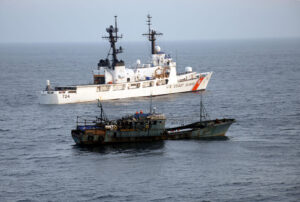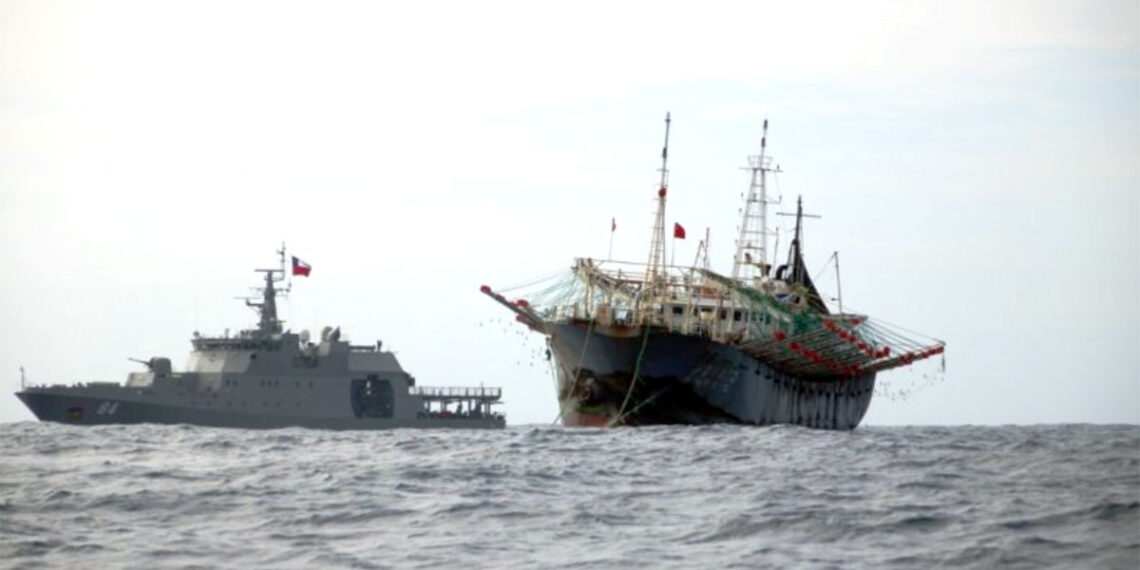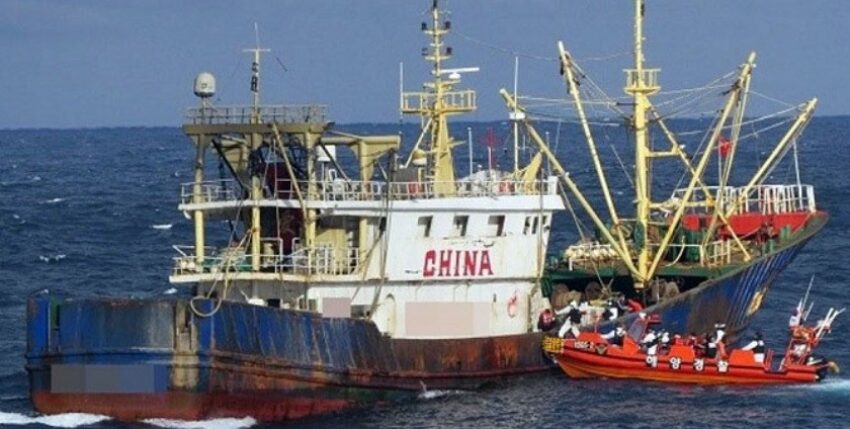China is consolidating its territorial claims in the South China Sea with artificially created islands. Aggressive fishing fleets and maritime militias are also intended to ensure that its citizens are fed.
The G7, NATO and EU meetings of the American president in June 2021 at the latest made Europeans realise that they need to reposition themselves with regard to the People's Republic of China. This is no longer just about flying the military flag in the South China Sea, but about future political, economic and technological dealings with a country that has long been preparing to become the number one superpower. The European Council on Foreign Relations states: "China is willing to impose economic penalties in order to change EU policy." And these economic penalties could also include the massive deployment of maritime militias and fishing fleets in the future. These are militarily under the command of the Chinese Communist Party (CCP) and the sheer number of their vessels means that they are able to force residents, merchant shipping and fisheries to change their behaviour in line with China's wishes. This could take place below the threshold of armed conflict. Such a grey area has already been used by China in the construction of artificial islands in the South China Sea. China already owns 60 per cent of the world's fishing fleet and 60 per cent of all imports of fishery products into the EU come from the Asian country.
China's maritime forces
The book "China's Maritime Gray Zone Operations" provides a good introduction to the topic. It was published in 2019 by Andrew S. Erickson and Ryan D. Martinson as a joint publication of the China Maritime Studies Institute at the Naval War College and the US Naval Institute. It discusses the growth and deployment of China's three maritime forces, which are already the largest in the world in quantitative terms: the People's Liberation Army Navy (PLAN), the coast guard and the maritime militia. These forces are supported by the largest fishing fleet in the world, one of the largest merchant navies, a rapidly growing global network of permanently usable harbours and a large fleet of tankers sailing under national flags. With this potential, more than 600 years of dominance by Western navies on the world's oceans could come to an end.
In the introduction, five authors analyse the conceptual development of Chinese operations in grey areas. They emphasise the special significance of the maritime militias as paramilitary forces, describe their deployment strategies and the difficulties in applying international law to them. The third part examines the units and their increased use in maritime militia operations in legal grey areas. These operations are used for surface and underwater surveillance and to prevent fishing by neighbouring states in their exclusive economic zones (EEZs). This is done by forcing fishing boats off the water by means of aggressive course changes and ramming actions. This is intended to manifest Chinese legal claims to the exclusive use of large parts of the South and East China Seas. In conclusion, the editors conclude that China's strategy of a war without a sharp shot will continue to be successful unless resolute countermeasures are taken. They therefore develop options for a decisive deployment of American naval power off China's coast. So far, the US Navy has been successful in its freedom of navigation operations, as China has only protested politically but has not deployed its own naval forces in defence. Nevertheless, China has successfully expanded its influence in the South and East China Seas with salami-slicing tactics since 2006. And this is likely to continue after President Xi Jinping's speech on the 100th anniversary of the Chinese Communist Party on 1 July 2021.
Back in 2017, Erickson and Conor M. Kennedy published a remarkable report entitled "China's Third Sea Force, The People's Armed Forces Maritime Militia: Tethered to the PLA". In it, conclusions were drawn from countless open Chinese sources about the tasks, missions, structures and lines of command of the maritime militia. They can be summarised as follows:
- Leading elements of China's maritime militia have been at the forefront of incidents and skirmishes with foreign vessels in the South China Sea.
- The militia is a key element of the Chinese armed forces and part of the so-called People's Armed Forces System
- People's Armed Forces Maritime Militia (PAFMM) is therefore the most appropriate name for China's third naval force.
- The involvement of PAFMM forces in incidents and provocations in international waters was often at the direction of the PLA, and sometimes other Chinese maritime law enforcement agencies.
- The PAFMM is a state-organised, developed and controlled force that carries out state-sponsored activities under the direct command of the armed forces.
Pacific region
The analysis and pictorial representation of the military and political chain of command has contributed significantly to the re-evaluation of these forces in the American political and military establishment. Since then, it has become an integral part of possible threat scenarios, not only in strategic papers on the defence of US interests, but also in reports to Congress and the White House.

In this context, it is interesting to note that thousands of employees of the Chinese fishing fleet are also registered members of the maritime militia. Their ships no longer only appear in large swarms in the South and East China Seas and obstruct the work of fishing vessels from Vietnam, the Philippines, Japan and even the USA. Even far from their own coastal seas, such actions are taking place in the depths of the Pacific as far as the EEZs of Peru and Ecuador.
Not all states that live from fishing have the means to protect their interests with police forces against intruders in their national waters. This has created a free space for third-party activities that are summarised under the term illegal, unreported and unregulated fishing (IUU). This type of fishing has now replaced piracy as the greatest maritime threat to world shipping. In a study from 2020, the commander of the US Coast Guard outlines ways in which this challenge could be tackled in the future.
It is also about the fundamental question of how a growing world population can be fed. The ruthless predatory fishing of some countries poses a major problem here. These few countries are also undermining the attempts of many other nations to conserve animal stocks through sustainable fishing and thus to be able to feed future generations with fish. Of particular importance are the fleets of China and Taiwan (together 60 %), Japan, South Korea and Spain (10 % each), which together account for 90 per cent of deep-sea fishing. A regime coordinated with these countries is therefore needed to conserve fish stocks. And this reveals the biggest problem in this context: a lack of agreement with China, which has so far rejected any international regulation and arbitration.
Looking back over the last five years, the European Union can point to some successes with its EU IUU Fishing Coalition, in which 91 countries worldwide are now participating. In the meantime, most of the participating countries have come closer to the required EU standards. One important exception is China with its huge fishing fleet. So far, there has been no mention of how to deal with this problem in publications by the European Union or Germany, nor in the annual reports of the Marine Command to date.
Monitoring required
In comparison, the US Coast Guard commander's description of the situation and his recommendations speak for themselves. He reports an increase in the amount of fish caught each year, an increase in possible fishing under commercial conditions in the Arctic and Antarctic due to the effects of climate change, but also fish migrations from southern waters to the north and a continuous decline in fish stocks in African and South American countries around the equator. All of this leads to difficulties in feeding the local population.

The US Coast Guard is therefore calling for global monitoring by intelligence services, the exchange of information obtained, legal support and the provision of political information to coordinate operations, in addition to the monitoring of its own exclusive economic zone that has been standard practice for decades. This is a prerequisite for the preservation of sufficiently large fish stocks for future generations.

Here too, the question of how to deal with Chinese fishing vessels that refuse to allow third parties to inspect their fishing remains unanswered. How should other states be supported if the Chinese maritime militia appears with a large number of vessels in the EEZ of another nation outside the South China Sea to enforce good behaviour towards Chinese fishing? How to deal with future Chinese commercial fishing in the Arctic despite a formal ban? How to deal with Chinese fishing vessels and factory ships appearing in international waters of the North Atlantic by maritime militia vessels?
Until now, the biggest shortcoming of Western states was that they did not understand China's behaviour below the threshold of war and therefore did not react adequately. The USA also had to admit this with its (non-)reaction in the South China Sea. China wants to turn the EEZ of the South China Sea neighbours into a security zone for itself. It is therefore important to defend the unhindered use of the high seas as guaranteed by international law. It is also important to realise that China is deploying its coast guard and maritime militia to serve the political interests of the CCP just as much as the PLAN. This means that the USA must credibly protect its allies in the Indo-Pacific, especially in the South China Sea and East China Sea, and defend its own interests.
The following fundamental questions arise for Europeans: Do we need another decade before we address the security policy significance of the high seas far from our own coastal waters in the shadow of the rising world power China? Not in discussion rounds, but with operational planning based on simulation games involving the ministerial level, the German (logistics) industry, the responsible state authorities and the armed forces. Understanding the sea also means thinking maritime. A thought by author Thomas Bagger fits in with this: "One of the difficult challenges of a new German government will be to make the Germans accept the reality of a rougher world."
Heinz Dieter Jopp










